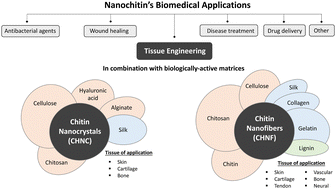The role of nanochitin in biologically-active matrices for tissue engineering-where do we stand?
Abstract
Our regard to the use of chitin as a material has drastically changed since its discovery, 210 years ago. From an intractable material because of its insolubility in common solvents, it became one of the most important raw materials serving as a source of chitosan (its main derivative), and more recently, as source of nanometric forms: nanocrystals and nanofibers. Nanoscale chitin forms are remarkable high-value compounds for nanomaterials’ development, due to their intrinsic biological and mechanical properties, as well as their potential as eco-friendly components to valorize the plentiful by-products of the seafood industry. Lately, these nanochitin forms have been widely used as nanofillers in polymer nanocomposites, and in particular, in natural biologically-active matrices for the development of biomaterials. The recent progresses achieved in the last two decades concerning the use of nanoscale chitin in biologically-active matrices for tissue engineering is highlighted in this review. First, an overview on the use of nanochitin in the different biomedical fields is presented and discussed. Then, the state-of-the-art regarding the development of biomaterials based on chitin nanocrystals or nanofibers is described in the context of the role of nanochitin in biologically-active matrices namely polysaccharides (chitin, chitosan, cellulose, hyaluronic acid, alginate), proteins (silk, collagen, gelatin) and others (lignin). Finally, major conclusions and perspectives on the use of nanochitin as an increasingly important raw material are described.

- This article is part of the themed collections: Journal of Materials Chemistry B Recent Review Articles and #MyFirstJMCB


 Please wait while we load your content...
Please wait while we load your content...